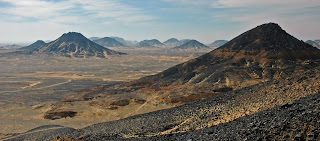Wadi Al-Hitan is also called Whale Valley, situated in the Western Desert of Egypt, contains precious fossil remains of the earliest, and now extinct, suborder of whales’ offers dramatic evidence of one of the iconic stories of evolution. These fossils represent foremost stories of evolution and emergence of the whale as an ocean-going mammal from a preceding life as a land-based animal. This is considering the most prominent world site for demonstration of stage of evolution, because it portrays brightly the form and life of these whales during their transition. The quality of fossils is unique as their accessibility and setting in an attractive and protected landscape. The Al-Hitan fossils show the youngest archaeocetes, in the last stages of losing their hind limbs, while the other fossil material in the site makes it feasible to reconstruct the surrounding environmental and ecological conditions of the time. This beautiful World Heritage property is a firmly protected sector, set within the wider landscape of the attractive Wadi El-Rayan Protected Area. It is an exceptional global reference site because of the number, concentration, quality and accessibility of the evidence of the earliest whales, often in the form of complete skeletons, and the record of the environment that they lived in. . Fossil shells are not common in the main whale-bearing rocks, but are very common in other rocks; many fallen rocks can be seen to be full of a wide variety of fossil shells. No other place in the world yields the number, concentration and quality of such fossils, as is their accessibility and setting in an attractive and protected landscape. This is why it was added by the UNESCO to the list of protected World Heritage sites.
Wadi Al-Hitan (Whale Valley) is State owned and has strong and unequivocal legal protection under the Egyptian Law (102/1983) for Nature Protectorates reserves, forbidding actions that would lead to destructions or deterioration of the natural environment. The law mentions geological features as specific elements receiving protection. The Wadi El-Rayan Property Protected Area (WRPA), is managed under national regulatory law on Nature Protectorates. The NCS (Nature Conservation Sector) of the EEAA (Egyptian Environmental Affairs Agency) is responsible for the management, protection and conservation of the entire site, as part of its overall management of the WRPA. The geology of the valley gives rise to the scenery, with wind and water erosion producing spectacular cliffs and buttes. The rocks present at Wadi Al-Hitan are all Middle to Late Eocene in age and comprise three main rock units.
Now an efficient management system is in place for the property, which is integrated part of the implementation of the Management Plan for the WRPA. Under the updated Management Plan the property is identified as a “World Heritage Zone”. No vehicle access is allowed, whilst zones provide for well-controlled eco-tourism in part of the property, whilst maintaining areas for research and studies. The buffer zone is well managed as a part of the World Heritage Zone within the WRPA. Effective and well designed visitor facilities are offering to present the property, educate the visitors to key localities via footpaths, avoid vehicular traffic in the property and give limited on-site accommodation. There is a planning team in charge for day-to-day management of the property, and the preparation of annual plans and monitoring and reporting on the effectiveness of its management. Effective maintenance is well-resourced which is healthy supported by adequate staff, finance and resources are vital long term requirement, and key management issues are the protection, conservation and encouragement of well-managed research in relation to the fossil remains and the associated geological values, to international standards of best practice.
Only about 1,000 visitors a year drive into wadi Al-Hitan by 4WD because the track is unpaved and crosses unmarked desert sands. For the most part, visitors to wadi Al-Hitan are foreigners, who usually camp in the valley on winter weekends. Sustainable tourism is start to develop and grow in the area, and the 4WD are alternatively being replaced by foot or camel treks. Since part of Wadi Al-Hitan was made into a tourist venue, walkways between the main fossils were laid out and small shelters built. This public park is now regularly visited by tourist groups, and a small camp site is present. The valley is located behind a mountain, known as Garet Gohannam, gara means hill or mountain of hell. In the light of the setting sun, the mountain seems ablaze with red light. In July 2007, a pair of cars driven by Belgian diplomats entered in protected area, and The Egyptian government has alleged damage of worth 325,000 US dollars. The Belgium government has said no damage was caused by its diplomats. The issue remains unresolved.
+Egypt0.jpg)
+Egypt1.jpg)
+Egypt2.jpg)
+Egypt3.jpg)
+Egypt4.jpg)
+Egypt5.jpg)
+Egypt7.jpg)
+Egypt8.jpg)
+Egypt11.jpg)
+Egypt13.jpg)
+Egypt14.jpg)
+Egypt15.jpg)
+Egypt17.jpg)
+Egypt18.jpg)
+Egypt19.jpg)
+Egypt20.jpg)
+Egypt21.jpg)
+Egypt22.jpg)
+Egypt23.jpg)
+Egypt.jpg)










+Egypt1.jpg)
+Egypt2.jpg)
+Egypt3.jpg)
+Egypt4.jpg)
+Egypt5.jpg)
+Egypt7.jpg)
+Egypt8.jpg)
+Egypt11.jpg)
+Egypt13.jpg)
+Egypt14.jpg)
+Egypt15.jpg)
+Egypt17.jpg)
+Egypt18.jpg)
+Egypt19.jpg)
+Egypt20.jpg)
+Egypt21.jpg)
+Egypt22.jpg)
+Egypt23.jpg)
+Egypt.jpg)



















